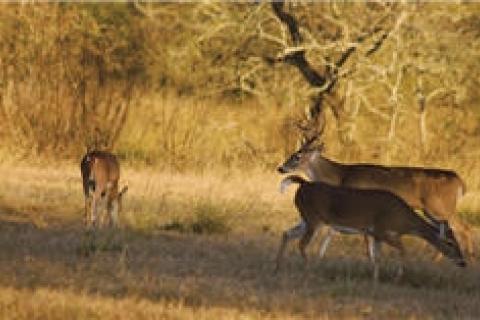
Article by Gerald Almy.
You know the drill.
Find doe family groups as the rut approaches, take a stand downwind, kill a big buck. If only it were that simple.
The fact is, you need to find the right does. Different groups of females, even in a small hunting area, cycle at slightly different times. (If they didn’t, the main estrous period would last about one and a half days instead of seven to 10.) Finding a doe group that’s cycling or just about to cycle can up your success dramatically.
Mature bucks monitor the status of females constantly as peak rut approaches. They’ll visit different doe groups, watching for visual signs and scent-checking for pheromones that
 |
| Photo of deer courtesy of Bass Pro Shops. |
tell them exactly which does are ready and which aren’t. Once the first group comes into full heat, however, this visiting comes to a screeching halt. If you’re sitting near does that won’t cycle for another three days, you could have a long, cold wait. And you could be missing hot action with another group just a quarter mile away.
Get on Schedule?
How do you find the hottest does on your property? One way is to pay close attention to rutting activity on different parts of your ground over several years. If you take careful notes in a journal or on a calendar, you can eventually create a rut hunting schedule. Having done exactly that, I have found, for example, that a group of does in a cool, higher part of my property always breeds early, so I set up there for my first rut hunts. Once they finish, a group that holds near a prime feed area in the lowlands comes next, followed by two groups scattered in the middle of the property. Each year, the scenario plays out over a full week or more, allowing me to stretch my rut hunts out and be in the right place at the right time.
Read the Signs
?If monitoring actual estrous schedules isn’t practical, simply paying attention to climate, habitat, and doe behavior can help tip you off to which females are cycling. If one part of your property is cooler than another—say, because of higher elevation as in my example—does living there will tend to cycle first, making this the first place you should check for early rutting action. Otherwise, ask yourself where the best habitat is located. Find the spot where choice foods are surrounded by premium cover in the form of low brush, tall grasses, scattered trees and saplings, and edible shrubs like honeysuckle, blackberry, olive, and raspberry. The oldest doe around typically claims this spot and comes into heat early, before younger does. On the flip side, expect groups living in lesser habitat to breed later in the season.
In any case, you can tell when does are approaching estrus by their behavior. They’ll be on their feet more, pacing. They won’t typically leave their home turf, but they’re restless and want to waft out their I’m-almost-ready pheromone scent to nearby bucks. They act antsy and look back over their shoulders a lot. Their tails may stick straight out or be crooked to one side.
If the does you see look relaxed and mostly interested in food, with no nervousness or edgy demeanor, search for another group. If they kick at bucks that approach to sniff them, move on—but make a mental note to check back on them in a few days. Females that run playfully from approaching bucks but aren’t really trying to get away are what you want. That’s where the biggest bucks in the area are going to be for the next few days. It’s a short window of opportunity, but if you time it right and camp out downwind of the does’ primary bedding or feeding area, you can have some incredible action. Stay there until the activity wanes or you put a tag on one of the suitors.
Originally published on the Field & Stream Rut Report: A Whitetail Deer Season Tracker
Published here with permission from Field & Stream
- 2669 views

